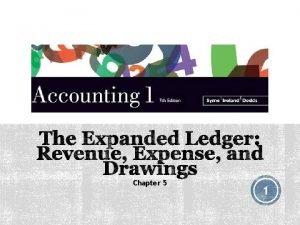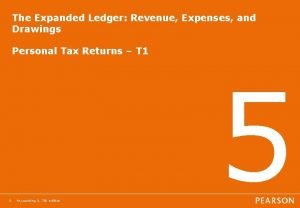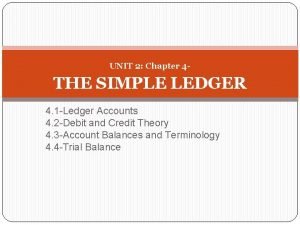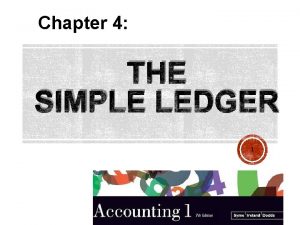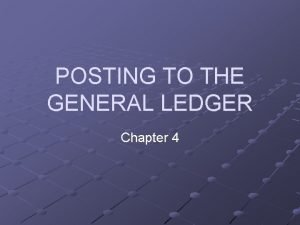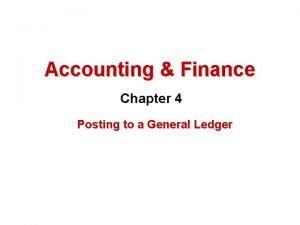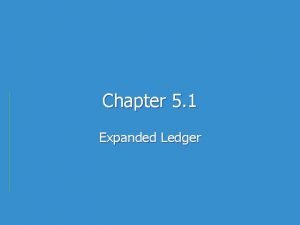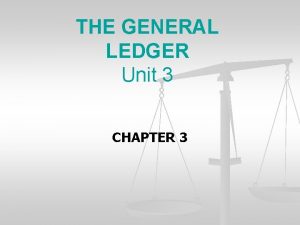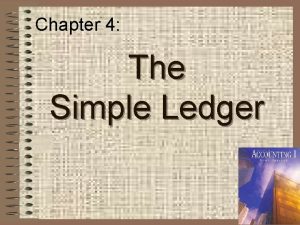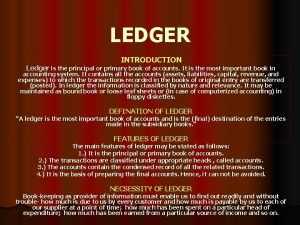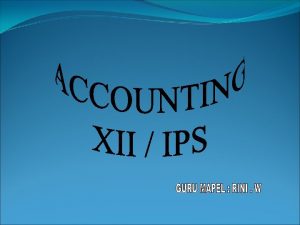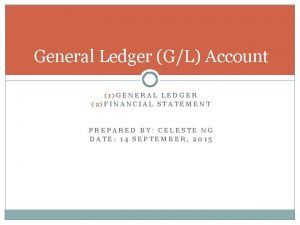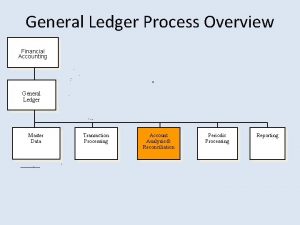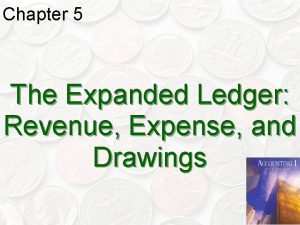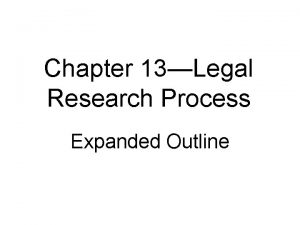Chapter 5 The Expanded Ledger 1 Chapter 5






































- Slides: 38

Chapter 5 The Expanded Ledger 1 Chapter 5 – The Expanded Ledger l Accounting 1, 7 th Edition 5

Agenda v v v v 2 How to divide the Capital account to: capital, drawing, revenue and expenses How to create a more detailed balance sheet and trial balance with an expanded ledger How to make an income statement from the expanded trial balance What is an income statement How to make an income statement Parts of the income statement Uses of the income statement Equity section summary Presentation Title runs here l 00/00/00

Learning goals Be able to create an Expanded Ledger v Create a Trial Balance with Expended Ledger v Create an Income Statement from the Expended Ledger v Understand how the Equity Business Principle, revenue Recognition Principle and Matching principle apply to the Expanded Ledger v 3 Presentation Title runs here l 00/00/00

Learning goals Understand the Fiscal Period and time period concept v Explain the role of financial analysis in decision making from the standpoint of potential investors such as an investor. v Describe how accounting information is used by individuals or organizations outside the company such as owner/manager, bank and tax authorities v 4 Presentation Title runs here l 00/00/00

Vocabular Drawings Equity equation Expense Financial period/ accounting period/ fiscal period Income statement Income tax return 5 Presentation Title runs here l 00/00/00 Matching principle Net Income Net loss Revenue recognition principle Time period concept

5. 1 The Expanded Ledger and Income Statement . This lesson will cover how to use the balance sheet to create an expanded ledger. Up to Chapter 4, only the capital account is used for owner’s equity. In Chapter 5, you learn that there are several other equity accounts. 6 Chapter 5 – The Expanded Ledger l Accounting 1, 7 th Edition

The Expanded Ledger In the old Chapter 4 system, there is only a single equity account. 7 Chapter 5 – The Expanded Ledger l Accounting 1, 7 th Edition

The Expanded Ledger The Chapter 5 ledger expands upon the old version. 8 Chapter 5 – The Expanded Ledger l Accounting 1, 7 th Edition

The Expanded Ledger The Chapter 5 ledger expands upon the old version. 9 Chapter 5 – The Expanded Ledger l Accounting 1, 7 th Edition

The Expanded Ledger To begin expanding the ledger, extract the beginning capital amount. 10 Chapter 5 – The Expanded Ledger l Accounting 1, 7 th Edition

The Expanded Ledger Next, extract drawing. -drawings: withdrawals of money from the company for personal use. - 11 Chapter 5 – The Expanded Ledger l Accounting 1, 7 th Edition

The Expanded Ledger Extract the revenue amounts (known as “fees earned” if the company sells a service, or “sales” if the company sells a product). 12 Chapter 5 – The Expanded Ledger | Accounting 1, 7 th Edition

The Expanded Ledger Finally, extract the individual expense amounts into their own separate accounts. 13 Chapter 5 – The Expanded Ledger | Accounting 1, 7 th Edition

The Expanded Ledger With the expanded ledger accounts, you can create a more informative trial balance and balance sheet. You are now also able to generate an income statement. 14 Chapter 5 – The Expanded Ledger | Accounting 1, 7 th Edition

The Expanded Ledger Asset and liability accounts remain unchanged. 15 Chapter 5 – The Expanded Ledger l Accounting 1, 7 th Edition

The Expanded Ledger Owner’s equity accounts are expanded. 16 Chapter 5 – The Expanded Ledger | Accounting 1, 7 th Edition

The Expanded Ledger The new calculation looks at beginning capital, plus net income, less drawings, plus increase in capital. 17 Chapter 5 – The Expanded Ledger | Accounting 1, 7 th Edition

The Expanded Ledger Once you have calculated the total owner’s equity you can rule and total and complete the balance sheet. 18 Chapter 5 – The Expanded Ledger | Accounting 1, 7 th Edition

The Expanded Ledger Another view of the trial balance. The expanded ledger accounts can be used to generate the income statement. 19 Chapter 5 – The Expanded Ledger | Accounting 1, 7 th Edition

The Expanded Ledger Another view of the trial balance. The expanded ledger accounts can be used to generate the income statement. 20 Chapter 5 – The Expanded Ledger | Accounting 1, 7 th Edition

The Expanded Ledger The income statement consists of all revenue and expense accounts, which are part of the expanded ledger. 21 Chapter 5 – The Expanded Ledger | Accounting 1, 7 th Edition

Income Statement Income statement: is a financial report, that shows the revenue of a business, subtracts its expenses, and reveals the profit made for a given period of time. v You use the new expanded equity account to prepare the income statement v. NOT INCLUDED ARE CAPITAL AND DRAWINGS. We will learn how to record those accounts correctly later v 22 Presentation Title runs here l 00/00/00

23 Presentation Title runs here l 00/00/00

Income Statement Same like a balance sheet is a formal statement seen by other people who are important for the business 24 Presentation Title runs here l 00/00/00

Income Statement Who, What and When in the header When: Month ended of… (income statement summarize the activity that took place during that time) 25 Presentation Title runs here l 00/00/00

Income Statement Same underline and dollar sign rules as a balance sheet: -Single line above the total number -Single line bellow the number being totaled -Double underline for the final net -dollar signs on the first revenue, expense and net income 26 Presentation Title runs here l 00/00/00

Income Statement – part of the income statement Revenue or income Is an increase in equity resulting from the sale of goods or services in the usual course of business activity. Expenses Represent a decrease in equity resulting from the costs of operating the business. The purpose of expenses is to produce revenue or to support revenue making activities. Net income or Net Loss Net income is the difference between total revenue and total expenses, where the revenue are greater than the expenses. Net loss is when the expenses are greater than the revenue. 27 Presentation Title runs here l 00/00/00

The Income Statement Put to Use By the owner: tells the owner or manger I their business is earning a profit and how much. By bankers: bankers need to know if the borrower will be able to repay the loan By investors: investors will provide cash for business that there is a good chance of future profits. By Income Tax Authorities: every business required by law to pay taxes. Income statement is a main tool used in income tax return. 28 Presentation Title runs here l 00/00/00

Equity Section Summary There are four types of account in the equity section: 1. Capital: beginning equity figure, plus the investment from the owner. 2. Revenue: increases in equity resulting from the sale of goods or services 3. Expenses: decrease in equity resulting from the costs of the materials or services used to produce the revenue. 4. Drawings: decreases in equity resulting from the owner’s personal withdrawals. 29 Presentation Title runs here l 00/00/00

5. 2 Equity Transactions and Accounting Principle Revenue Transaction: Eve boa, a lawyer, draws up legal agreement for J. Basso, a client, and for her services is paid a fee of $450 in cash. 30 Presentation Title runs here l 00/00/00

Equity Transactions and Accounting Principle If another legal service for $700 was performed for B. Singh on credit 31 Presentation Title runs here l 00/00/00

The Revenue Recognition Principle Come from Generally Accepted Accounting Principles and is continued with International Financial Reporting Standards. Revenue recognition principle: requires revenue to be recorded (recognized) in the accounts at the time the transaction is completed. So you can credit the revenue account when the bill or invoice for that revenue is send to the customer. And if the seller has not other significant obligation with regards to the transaction. 32 Presentation Title runs here l 00/00/00

The Revenue Recognition Principle If you buy a computer online with a credit card, does the seller wait until it is delivered to you before recognizing revenue? What if a customer pays to you today for a service or product you will provide 3 months later? No! IFRS allows the seller to recognize revenue at the time of the sale without having to wait for redelivery as long as: (1)It is probable that delivery will be made (2)The item is on hand, identified, and ready for delivery (3)The buyer aware of delayed delivery (4)The usual payment terms apply You recognize the cash earned and you put a liability account called unearned revenue. We will talk about those later in the semester. 33 Presentation Title runs here l 00/00/00

Equity Transactions and Accounting Principle Expenses Transactions Eve Boa writes a $3300 cheque for the monthly rent payment 34 Presentation Title runs here l 00/00/00

The Fiscal Period Time Period Concept Net Income is calculated for specific length of time, called the fiscal period. v Fiscal period is also called financial period and accounting period v The formal fiscal period is usually one year but to satisfy the needs of investors, quarterly statement (ie, every three months) are common with public companies that trade their share son stock exchange. v Time Period concept: accounting will take place over specific time period known as fiscal period v 35 Presentation Title runs here l 00/00/00

Matching Principle States that: 1. Revenue must be recorded in the exact period that it is earned 2. Matching expenses for the revenue must be recorded Matching principle: each expense item related to revenue earned must be recorded in the same period as the revenue it helped to earn. 36 Presentation Title runs here l 00/00/00

The Expanded Ledger The new trial balance shows the expanded equity accounts. It is possible to determine net income and the balance of capital using the balances of these accounts. 37 Chapter 5 – The Expanded Ledger | Accounting 1, 7 th Edition

The Expanded Ledger The expanded ledger also makes the balance sheet more informative. 38 Chapter 5 – The Expanded Ledger | Accounting 1, 7 th Edition
 Drawings dr or cr
Drawings dr or cr Expanded equity section
Expanded equity section Debit credit format
Debit credit format The simple ledger chapter 4
The simple ledger chapter 4 Chapter 4 posting to a general ledger
Chapter 4 posting to a general ledger Chapter 4 posting to a general ledger
Chapter 4 posting to a general ledger Hình ảnh bộ gõ cơ thể búng tay
Hình ảnh bộ gõ cơ thể búng tay Lp html
Lp html Bổ thể
Bổ thể Tỉ lệ cơ thể trẻ em
Tỉ lệ cơ thể trẻ em Voi kéo gỗ như thế nào
Voi kéo gỗ như thế nào Chụp phim tư thế worms-breton
Chụp phim tư thế worms-breton Hát lên người ơi alleluia
Hát lên người ơi alleluia Các môn thể thao bắt đầu bằng tiếng chạy
Các môn thể thao bắt đầu bằng tiếng chạy Thế nào là hệ số cao nhất
Thế nào là hệ số cao nhất Các châu lục và đại dương trên thế giới
Các châu lục và đại dương trên thế giới Công thức tiính động năng
Công thức tiính động năng Trời xanh đây là của chúng ta thể thơ
Trời xanh đây là của chúng ta thể thơ Mật thư anh em như thể tay chân
Mật thư anh em như thể tay chân 101012 bằng
101012 bằng Phản ứng thế ankan
Phản ứng thế ankan Các châu lục và đại dương trên thế giới
Các châu lục và đại dương trên thế giới Thể thơ truyền thống
Thể thơ truyền thống Quá trình desamine hóa có thể tạo ra
Quá trình desamine hóa có thể tạo ra Một số thể thơ truyền thống
Một số thể thơ truyền thống Bàn tay mà dây bẩn
Bàn tay mà dây bẩn Vẽ hình chiếu vuông góc của vật thể sau
Vẽ hình chiếu vuông góc của vật thể sau Nguyên nhân của sự mỏi cơ sinh 8
Nguyên nhân của sự mỏi cơ sinh 8 đặc điểm cơ thể của người tối cổ
đặc điểm cơ thể của người tối cổ V cc
V cc Vẽ hình chiếu đứng bằng cạnh của vật thể
Vẽ hình chiếu đứng bằng cạnh của vật thể Phối cảnh
Phối cảnh Thẻ vin
Thẻ vin đại từ thay thế
đại từ thay thế điện thế nghỉ
điện thế nghỉ Tư thế ngồi viết
Tư thế ngồi viết Diễn thế sinh thái là
Diễn thế sinh thái là Dot
Dot Số nguyên tố là số gì
Số nguyên tố là số gì
